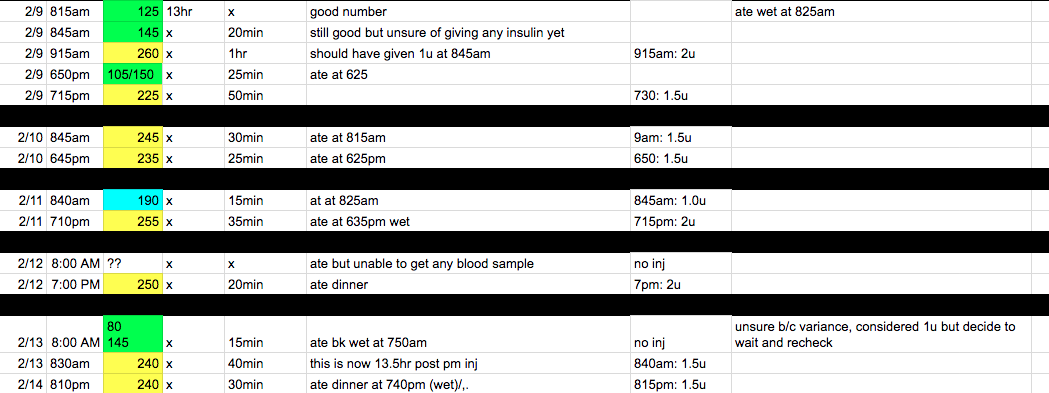Diabetes in Dogs – A Growing Problem
Do you have a dog with diabetes? If so, this page can help you. I know it’s a scary time for you right now and you probably have a LOT of questions. I’m sure you’ve already Googled “Diabetes in Dogs,” “Canine Diabetes,” “How to give an Insulin Shot for Dogs” and lots of other things, right? But just for a moment take a breathe and accept the fact that while you may not be able to change the fact that your dog has diabetes, you CAN help your dog – and better yet you can provide much of that care in the comfort of your own home. I’ll show you how to care for your diabetic dog with this tips on this page…

Diabetic Dogs – A Tribute
This page is dedicated to our angel – Baby Sassy (the wonderful yorkie you see in our diabetes videos), to Lil B (who is still the commander of our household in spite of her diabetes) AND to all the many beloved doggie friends and their owners who I’ve had the privilege to help over the years.


Why Listen to Me?
My name is Mike (known as That Helpful Dad on this site, YouTube, and elsewhere) and I’ve been ‘blessed’ to have TWO dogs with diabetes – apparently there are a number of dog breeds susceptible to developing canine diabetes and Yorkies are one of them, as are many other small breed dogs.
Although Sassy lived for multiple years with diabetes, she passed away back in 2011, however Bella is still with us – getting her insulin shots every day and still as feisty as ever.
In addition to my hands-on experience as the father of two diabetic dogs, in an ironic twist of fate, for about 5 years PRIOR to Sassy developing diabetes I was actually a pharmaceutical sales rep for insulin products – as a result, I learned a great deal about diabetes in general, insulin, and insulin injections (I happened in to that career by chance – or so I thought! – but now I realize that my career change was all part of God’s plan – He was preparing me to help Sassy, Bella, and many other dogs later). Perhaps I can help YOU too?
A Word of Caution
Understand this, I’m not a vet nor do I pretend to be one. I’m just a loving parent whose been where you are right now – but I’ve learned a lot along with way and because I’ve shared my tips on YouTube in the past, I often get asked for more advice. Over the years I’ve collected my tips and that’s what I’m sharing with you today.
I am NOT telling you to try to care for your diabetic dog without the help of a vet.
Hopefully you have a great vet who can partner with you in the process of caring for your dog and if so, that’s awesome.
Where my tips can help you is in the care of your dog AT HOME.
We love our dogs just like our kids – always have. I’m sure you feel the same. As I said above, I realize this is a scary time for you, but take heart in the fact that you CAN DO IT and your dog needs you. After a month or so, it will all become like normal for you.
Ready to get started?
Videos on How to Care for your Diabetic Dog at Home
Diabetes in Dog – Home Care Tips
Why should I check my dog’s Blood Glucose at home vs just letting the vet do it?
Although I am not a vet, I am very disappointed to hear that many vets do not encourage you to check your dog’s blood sugar at home. If you are capable of doing it (which you are) then why would you not want to know what your diabetic dog’s blood sugar is at on a daily basis?
Knowledge is power and when you are talking about diabetes in dogs knowing your dog’s blood sugar is critical.
How do you know how much insulin to give if you do not know your dog’s blood sugar prior to injection?
Doing a blood glucose check of your dog at home gives you this knowledge – and make you much more confident that the amount of insulin you are giving your pet is what they need.
If you don’t know your dog’s blood sugar and you give them their insulin shot, there is always the chance that if your dog’s blood sugar is already low (i.e. they really don’t need any (or as much) insulin as you are giving them), then the insulin you are injecting could be dangerous to them because it could drive their already low blood sugar even lower. And if it gets too low, they could suffer a serious hypoglycemic (‘low blood sugar’) episode or worse.
At the same time, if your dog’s blood sugar is higher than normal, but you don’t know that because you didn’t test their blood sugar first, then you may not be giving them enough insulin – as a result your dog will probably stay in a high blood sugar range and the insulin shot you gave probably won’t accomplish much.
The key to the entire operation is knowing your dog’s blood sugar. When you know that, you can give them the RIGHT dose of insulin and that means you’ll increase the odds that your dog will remain under good glucose control (which means they will be healthier overall and they will feel better too).
The bottom line about home glucose monitoring for your dog is this – because it’s so easy to get a blood sugar reading, it’s really quite foolish NOT to know.
Keeping a Journal of Blood Sugar Readings
Because things will change over time, we strongly recommend you keep a journal. Make notes about when your dog ate (make food notes if the meal is different than normal), what time you tested their blood sugar, how much insulin you gave, and how the dog is acting. With Sassy back in the day, we kept our journal in a spiral bound notebook. With our current Yorkie Bella, we keep it online in a Google Sheet File (similar to an excel document but in the cloud – this allows my wife and I to access it anywhere, anytime. Here is an example of it…
(Optional) When you first start checking your dog’s blood sugar at home, we recommend you test often so you get an idea of what is happening to your dog throughout the day — record all of this in your journal. A good schedule to start would be: prior to first meal, (eat), 30 minutes after meal (give insulin), 2 hours post-meal, and perhaps 4 hours post meal. Then repeat the process at dinner. That would be 6-8 tests for a few days – again with the goal of understanding how your dog is feeling during the entire day. I know that’s a LOT of tests, but this is just in the beginning and the goal here is to see some trends.
After you start to see the trends, then you can reduce the number of tests to something like 2-4 tests per day. At a minimum, I feel you need to do 2 tests per day – one before each injection (so that would be the test you do 20-30 minutes after the dog eats). Again, we believe you need to know the Blood sugar BEFORE you inject in order to give the right amount of insulin for your dog at that time.
How much insulin should I give my dog?
All too often I hear from folks that their vet said to just give the same insulin dose at the same time every day – without doing a Blood Sugar test.
This just seems very dangerous to me — as I said before, if you don’t know the Blood Sugar, what happens if you give insulin and the Blood Sugar is low? That extra insulin could cause real problems for your dog and drive them into a dangerous low blood sugar event such as hypoglycemic shock (or worse) — that could result in trip to the ER vet if the dog doesn’t recover quickly.
On the other hand, if your dog’s blood glucose is already high and you do not give enough insulin, then their blood sugar will stay high and your dog will continue to feel terrible – also, without enough insulin, all that food he just ate will probably NOT get processed by his body and he will likely end up just peeing out the nutrients and getting no benefits from the food or the insulin dose.
As I said before, a best practice is to keep a Journal of your diabetic dog’s feeding times, what his blood sugar was, and when/how much insulin you gave him. Then you can spot trends and fine tune the amount of insulin needed vs blood sugar readings.
Every dog is different as to how much insulin they need – it depends on their size, how much they eat, and how much of their pancreas is still producing insulin on its own. We used a ‘sliding scale’ of insulin amount provided based on our Sassy’s blood sugar readings.
For example:
Blood Sugar < 90 = 0 units of insulin
BS 90-150 = 1unit
150-200 = 1.5u
200-250 = 2u
250-300 = 2.5
300+ = 3u and recheck in 30minutes
IMPORTANT: our Sassy was a small yorkie (7 lbs) and your dog’s needs could be much higher.
I recommend you do as your vet suggests – which will probably be to start with a small amount (1-2units) and then check their blood sugar often in the beginning (perhaps every 2 hours just to see how he is reacting). Each meal, you can increase the dose if the blood sugar is still high.
Our goal was always to keep Sassy’s blood sugar in the ‘normal’ range (80-130) and we were happy if she was at least under 150, 2 hours post injection.
Mainly you want to avoid the extremes (Blood Sugar < 70 or > 400) because they could lead to dangerous consequences.
Most people tell me that their vets are happy if their diabetic dog has a blood sugar < 250 but that’s really quite high. Personally I think many vets tell their pet owners to shoot for around 250 because they know most people don’t test their dog’s blood sugar at home on a daily basis and that most people just give their dog the same amount of insulin every time as well. That’s less than ideal in my opinion because (for the many reasons we already discussed) it’s dangerous and makes it much more difficult for your dog to lead a normal life.
If you have the ability to simply check your dog’s blood sugar and give injections based on what they need that day, then you can help your pet lead a normal life and isn’t that the goal?
What happens if my diabetic dog’s blood sugar is below 70?
This is important – low blood sugar could lead to dangerous hypoglycemic episodes. Be sure to watch her closely and if need be get them to your vet immediately if you don’t think you can help them yourself.
Personally, we give our dogs a small amount of Karo syrup or molasses or something with fast acting ‘simple’ (i.e. easy to process) sugar because Blood Sugar below 70 is potentially dangerous and you want to get that up so they can avoid the consequences of hypoglycemia – which could be life threatening.
Karo syrup should raise your dog’s blood sugar quickly. If she wont take it, rub it on her gums with your fingers. Then recheck her in 20 minutes. If her blood sugar is below 50 and you can’t get it up, go to emergency vet immediately.
How long do I have to wait after a meal to give my dog their insulin injection? What insulin should I give them?
People often ask if they must wait 30 minutes post meal before giving their dog an insulin injection – it’s not an absolute.
Most vets who treat diabetes in dogs prescribe an insulin called “NPH” (brand names like Novolin, Humalin, Relion N) and if that’s what you are using then you should know that NPH is an ‘intermediate’ acting insulin. What that means is it starts working about 1-3 hours after you inject, lasts about 12 to 16 hours, and doesn’t really reach it’s ‘peak’ state until about 4-8 hours after you give the injection (the peak state is the time when NPH is causing your dog’s body to absorb the most glucose from the blood stream into the cells of their body).
If you watch the ‘Insulin Discussion’ video (above) then you’ll see I talk about that more (I think NPH is around the 3-minute mark of that video). That being said, the delayed peak of NPH is probably why many dogs may get hungry in the middle of the day (because the insulin is sucking up the most blood glucose at that time and your dog is craving more food).
NPH is a fine insulin, although I do believe 70/30 (brand names Novo 70/30, Humolin 70/30, N/R, and other names) is better because it has NPH in it PLUS it gives you a ‘faster acting’ insulin to cover the meals they just ate – the end result is keeping your dog in a more normal Blood Sugar range for as long as possible – and the more time that you dog can spend in a normal blood sugar range, the better they will feel and healthier they will be.
Note: please do not switch insulins without consulting your vet first.
What type of Blood Glucose Meter should I buy – does it have to be a canine-specific meter?
While it would be ideal to have a canine-specific Blood Glucose meter like Alphatrax or other brands you can get from your vet, I don’t think this is a ‘must.’
Why? First off Alphatrax is too expensive, not practical, and (in my opinion) doesn’t give you that much of a significant advantage vs a ‘human’ Blood Glucose meter that you can buy from Walmart or pharmacies.
The canine meters will likely cost you $50-300 for the meter alone and if you are testing 2+ times a day, the strips will probably run you $1-3 per strip – that would add up to significant costs very quickly and I fear would cause you to test less often – which would defeat the whole purpose.
Although I’m not a research scientist and I’m only telling you my opinion, I have done my own tests of the Alphatrax vs Walmart Relion, Accucheck, and Freestyle meters. If we assume the Alphatrax is the baseline, its true that none of the human meters exactly match the results of the Alphatrax, HOWEVER, they get pretty close.
I have read where some tests show the human meters consistently read lower than the canine meters by about 20-30%. In MY tests, the human meters are on average about 20-40 points lower from the Alphatrax BUT I found the difference is mostly at HIGHER blood sugar readings – since your greatest concern would be at the lower readings (because you want to ensure your dog avoids being too low) this difference is (in my opinion) not clinically significant enough to cause me concern and therefore I use the more practical human meters.
Think about it for yourself — if the differences are generally at the HIGHER Blood Sugar readings, does it really matter if the ‘exact’ Blood Sugar reading is 400 or 450? Both of those are high and the bottom line is your dog needs more insulin.
If you use a scale like the one I showed an exampled of above, then once you get over 400, you are probably at the highest dose of insulin you are going to give anyway, so it doesn’t matter if the Blood Sugar reading from the human meter is a bit off from the Alphatrax, right?
Personally We use the Relion Confirm meter – it costs about $15 at Walmart. The strips for this meter costs only 50cents a strip. At those prices, you can test all you want without going broke.
And that is the KEY – if you want to know how your dog is feeling and more importantly how they are responding to all your efforts to give them insulin, then you NEED to test the Blood Sugar yourself at home. And if you are going to do this quickly, easily, and cost-effectively, then you’ll likely just want to get a human Blood Glucose meter.
How much does a Blood Glucose test cost at the Vet vs Home?
Lately I have had a lot of emails from folks telling me their vets are charing $90, $150, and even $250 to do a Blood Glucose test at the office — and worse yet they are NOT wanting their pet owners to do the Blood Glucose testing at home. That is a real shame and I hope that’s not happening to you.
Sure, the test done at the vets (probably called a ‘fructosamine’ test on your bill) is going to be the most accurate way to test your dog’s Blood Gluocse, but who can afford to go to the vet every day or every week and have that test done?
Blood Glucose testing at home is still accurate enough to give you a really good idea of what’s happening with your dog. If you are like me, you want to know how your dog is feeling every day, right? Not just once a week or once a month at the vets office.
The good news is that you CAN get the information you need by doing the Blood Glucose test yourself on your diabetic dog at home. Then perhaps you only need to do the vet’s test once every 3 months and compare how it matches up to the average of your testing. That would be much more cost-effective AND give you a better overall picture.
Does it matter how much I feed my diabetic dog vs how much insulin I give?
Generally speaking, you would think the more your dog eats, the more insulin they will need to process that food but I would NOT change your dose based on how much you feed.
If you are going to use a sliding scale to change your insulin dose, that scale needs to be based on your dog’s Blood Glucose readings since that is going to be the number that tells you more accurately how much insulin your dog needs at that time.
I believe this is the safest way to dose your insulin for your dog with diabetes.
What type of food Should I give my diabetic dog?
There are now a lot of quality foods specific made for diabetic dogs and you will likely do fine with any of them – provided you give your dog the right amount of insulin they need (based on their Blood Sugar reading post-meal) to process that food and get the nutrients out.
That being said, we are big believers in home-cooked, fresh food based on the principles of The Whole Pet Diet. Here are some articles to help you…
You don’t necessarily need to cook if you don’t have time (although it doesn’t take as long as you think), just get a quality food WITHOUT a lot of grains/fillers. If you are going to switch to a homemade dog food (or do any food switch) you would want to do that gradually, perhaps just replace 1 meal a day at first.
I can tell you though that early on when we used store bought foods, our girls had more GI issues, however after changing to homemade stews, our girls RARELY ever had any problems with bad stools.
How regimented are the insulin shots?
Assuming you are feeding twice a day (breakfast/dinner), then if you use the NPH or 70/30 insulin that I talk about in the videos then you should give 1 shot after each meal.
We used the following method: feed, wait 30 minutes, check blood sugar, depending on level give XX amount of insulin.
30 minutes post meal should be plenty of time for your pet to begin processing the food he ate and then be ready for a shot with less risk of low blood sugars.
If you don’t check blood sugar prior to injecting and/or you don’t wait at least 15 minutes, then you could risk the insulin you’re injecting causing low blood sugar which could be very dangerous for your pet.
It’s always better to be a BIT high than too low.
What if I happen to miss an insulin shot due to something unforeseen?
It’s probably not a big deal occasionally. Your dog would just have high blood sugar for an extended period. That’s better than being too low but you want to avoid any extreme. If you go too long and his high blood sugar would eventually rebound to low blood sugar so you want to be sure to always feed before you give any insulin in my opinion.
What about in between meal snacks for my dog?
If your diabetic dog is still very active (runs around a lot outside) and/or you notice him sluggish in the afternoon, check is Blood Sugar and see if he’s running low – he may need an afternoon snack to replenish himself, but in that case you will NOT usually need to give another insulin injection because a snack is not a main meal and the 70/30 lasts about 12-16 hours anyway.
If he’s low, he needs carbs for food not just protein – a piece of wheat bread dipped in chicken broth, peanut butter (carbs/protein), watermelon/fruit.
If he is very low (under 70), then he needs FAST acting carbs – like molasses or Karo syrup to get him sugar immediately – rub this on his gums if he refuses to take it.
If you are using 70/30 or NPH twice a day, remember that it does ‘peak’ about 4-8 hours after you give it so it would be very normal for your dog to want/need food around that time.
What about exercise for dogs with diabetes?
Regarding exercise vs glucose, the insulin is not what goes up, but actually the Blood Sugar could rise.
Here’s a good explanation from the web: “When you exercise your muscles need more glucose to supply energy. In response, your liver increases the amount of glucose it releases into your bloodstream. Remember, however, that the glucose needs insulin in order to be used by your muscles. So if you do not have enough insulin available, your blood glucose levels can actually increase right after exercise. Basically, stimulated by the demand from your exercising muscles, your body is pouring glucose into your bloodstream. If you do not have enough insulin available to “unlock the door” to your muscles, the glucose cannot get into your muscles to provide needed energy. The end result is that glucose backs-up in your bloodstream, causing higher blood glucose readings.” All that being said, it does NOT necessarily mean that Your dog needs more insulin after exercising. If he is LOW after a walk, then he needs a fast carb snack like we talked about before, but if he is high it will usually come back down on its own as the glucose goes out of the bloodstream again.
If I live at a higher or lower sea-level is that going to affect my dog’s Blood Glucose readings or my insulin?
While sea level locations may affect insulin needs, from a clinical standpoint (i.e. real life), I would not get hung up on worrying about this. Before you get into fine-tuning vs sea-level you first need to master the basics – that’s doing your Blood Glucose readings consistently, keeping your journal, and using the sliding scale to adjust your insulin vs the Blood Glucose readings.
For 99% of folks, just doing those basic things will make a positive difference for you.
If you are still concerned about the higher-lower sea level, do additional research on the subject and tinker with MINOR adjustments but I doubt you will need to get to this stage.
Other Good Websites to Reference about Diabetes in Dogs:
https://www.akc.org/expert-advice/health/common-conditions/diabetes-in-dogs/
https://thebark.com/content/preventing-and-treating-canine-diabetes
https://canna-pet.com/diabetes-dogs-care-diabetic-dog/
https://www.wikihow.pet/Care-for-a-Diabetic-Dog
https://topdogtips.com/caring-for-a-diabetic-dog/
Were These Tips about How to Treat Canine Diabetes at Home Helpful?
If so, be sure to bookmark this page and considering sharing it on Facebook or Pinterest so others can benefit too.


